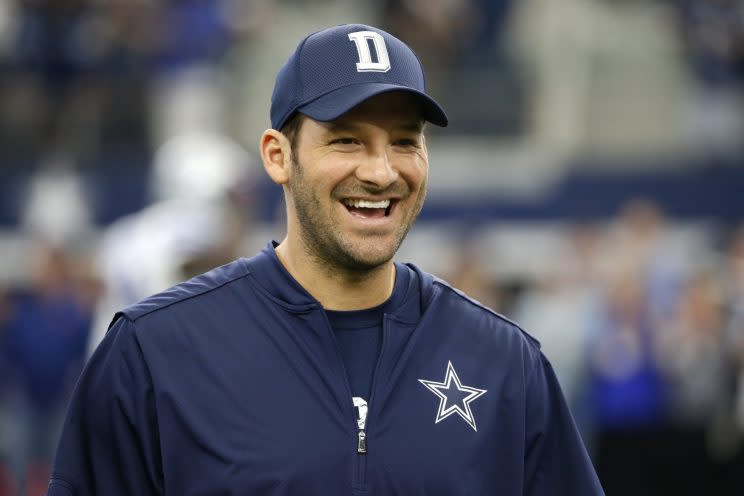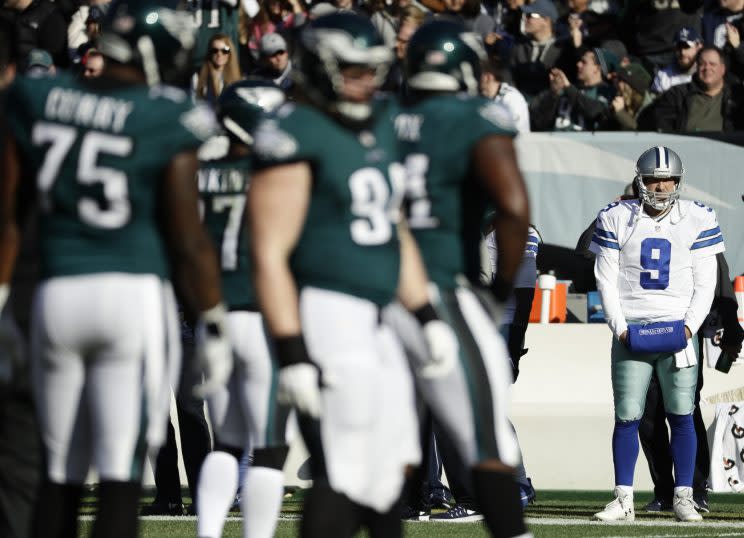Tony Romo must make one big selling point, and Broncos and Texans aren't shoo-ins as perfect fits
One series. Four passes. More mystery than ever. That’s the Tony Romo package.
As much as the NFL world at large is rushing to answer where the soon-to-be former Dallas Cowboy will land, there is a significant blind spot when it comes to who should want Romo now. Not just because he turns 37 in April. And not just because he’ll go into the 2017 slate having played parts of basically four meaningful games in more than about 31 months. But also because nobody outside of the Cowboys organization has seen what Romo looks like day-in and day-out since he broke his back in the 2016 preseason.

This, to put it mildly, is a concern.
While it’s assumed it was simply Romo’s hefty contract that kept teams away, the truth is there was another element in play. The fact that nobody has legitimate tape on Romo since his back injury. Yes, he played one series in the regular-season finale and threw four passes (including a touchdown). But that hardly passes muster in the NFL when it comes to seeing how far a quarterback has recovered from a back injury. Teams want to see a guy get hit, want to see him absorb punishment, and then want to assess how he moves around after that occurs. Especially if his game, like Romo’s, is steeped in mobility and improvisation. And the only team that really has an idea of how well he moves now is the Cowboys because they had him in practice every single day after he returned from his injury.
In that vein, it’s fair for NFL franchises to wonder if team owner Jerry Jones and the Cowboys might know something they don’t. And it’s also fair to suspect that the Tony Romo free-agent tour is going to seek to answer these concerns and questions. Romo, like Peyton Manning before him, will be expected to visit teams and go through some workouts before laying ink to contract terms. Indeed, teams won’t merely be selling themselves to Romo. He’ll have some selling to do, too, be it to the Denver Broncos or Houston Texans or whoever else will be installing him as a quality bridge quarterback or last-hurrah savior.
Romo is an attractive player if he can still move well – not just throw well. And one regular-season series since November 2015 isn’t a solid indicator of that. For that matter, neither are free-agent quarterback workouts. Teams need to see something before committing millions and shifting the axis of their franchise. And make no mistake, that’s what some clubs will be doing with Romo. Just take the two teams that are expected to fit Romo’s criteria – championship contender with a strong defense – for the next destination.
First, Denver. One of the most entertaining aspects of the “Where will Tony go?” conversation is listening to pundits talk about Romo’s potential fit with the Broncos. There is consistent waxing about general manager/de facto team owner John Elway and how this all harkens back to the Manning signing in 2012. It seems like such a perfect match, right? But inside that conversation, there isn’t a lot of discussion about how this isn’t the same team that won a Super Bowl after the 2015 season. Romo isn’t dropping into the middle of a Super Bowl team, no matter who suggests it.
Lest we forget, the 2016 Broncos went 9-7. That’s the roster Romo would be inheriting. Except that the offensive head coach, Gary Kubiak, is gone. And the defensive head coach, Wade Phillips, is gone. DeMarcus Ware likely won’t be back, either. That’s three very significant steadying voices out the door. There’s also the matter of an offensive line that does not appear to be better than last season’s mediocrity. This isn’t ideal considering protecting Romo should be a higher priority now than at any point in his career. And on top of all of that, the Broncos would be setting both of their young quarterbacks – Trevor Siemian and Paxton Lynch – to the side in hopes that Romo somehow is the element that puts it all together again. That sounds like an acceptable compromise in theory. But NFL quarterbacks develop by playing, not sitting for three years.
These aren’t small things. They’re big, potentially changing 2018, 2019, 2020 and beyond. That’s what a team would be tinkering with when it turns away from young quarterbacks it supposedly liked, in favor of a 37-year-old who hasn’t played in two years. Or foolishly assume the 2017 Broncos are a duplicate of the 2015 edition. For that reason alone – the ripples that could extend for years after Romo’s departure – it’s worth the Broncos thinking long and hard about whether this is worth the gamble, both financially and architecturally.

As for the Houston Texans, well, it looks like they don’t have much to lose. And if they’ve completely lost faith in Brock Osweiler ever being anything but a bottom-rung starter, then perhaps they don’t. Maybe the next failure is the last no matter who is starting under center. But signing Romo accomplishes one thing: It waves the white flag on ever developing Osweiler after only one season – effectively making him one of the worst quarterback signings in the history of free agency. And it’s hard to ever get that off a résumé, whether you’re head coach Bill O’Brien or general manager Rick Smith.
Of course, if Houston signs Romo and he delivers big, the Osweiler mistake gets washed away in celebratory champagne. The narrative becomes how the Texans did the toughest thing and admitted a mistake. It becomes a badge of honor. The flip side to that coin: Should the Texans admit that mistake and cast their lot with Romo, he better succeed in a big way. Anything less will look like a continuation of poor decision-making and an utter lack of sense when it comes to resolving a never-ending quarterback problem.
In short, replace a failing Osweiler with a flopping Romo and someone – maybe everyone – loses their job. Maybe even the untouchable Smith. Maybe the same thing would happen if Houston continued a prolonged struggle with Osweiler, too. But gambling on a young quarterback and losing happens in the NFL. Gambling on a young quarterback and then ditching him after only one season for another failing option … that tends to hang around on for an eternity.
Wherever Romo goes – whether it’s Denver or Houston or an unknown suitor – it shouldn’t be seen as the same no-brainer as the Manning signing. Romo isn’t Manning. And it’s unlikely he’ll be walking into anything as good as the four-year window Manning stepped into with Denver, either. That leaves a lot of mystery and concern in this next step. And that’s exactly why Romo will need to sell himself to teams every bit as much as the other way around.
More NFL free agency coverage from Yahoo Sports:
• Ranking the most interesting teams to watch in free agency, from 32 to 1
• The top 20 available free agents
• A list of the the franchise-tagged players

